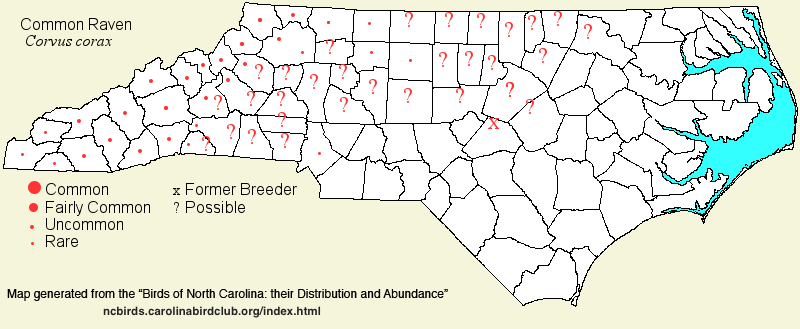 |  |
|
Common Raven - Corvus corax CORVIDAE Members: | Search Common: Search Scientific: |
|
|
|||||||
| General Comments | The Common Raven is considered to be the largest passerine in the world. It also is the one occurring farthest north, braving the harshest winters in the Arctic. It nests from coast to coast, and far southward in various mountain ranges. In North Carolina, it is primarily limited to the mountains. However, 100 or more years ago, it occurred sparingly toward the coast, and certainly must have nested on cliffs in Harnett, at aptly named Raven Rock State Park. Since about 1990, the species has slowly moved eastward across most of the Piedmont, nesting in a few scattered sites (mainly quarries), and often being observed along interstate highways looking for roadkill. Its status in the Piedmont is still quite uncertain -- are most of these sightings of immature birds, not yet nesting? For breeding, the raven always nests on horizontal surfaces -- usually ledges on cliffs, but also on quarry ledges and even in rafters of large buildings. They forage across very large areas, and seem more obvious in early morning when they fly over highways looking for overnight roadkills before traffic gets heavy, or rummage at garbage areas in parks before crowds arrive. They are quite shy and keep a good distance from man, typically feeding in more remote locations. | ||||||
| Breeding Status | Breeder | ||||||
| NC BRC List | Definitive | ||||||
| State Status | W | ||||||
| U.S. Status | |||||||
| State Rank | S3 | ||||||
| Global Rank | G5 | ||||||
| Coastal Plain | Formerly (prior to 1932), accidental/casual visitor to the coast: 2, Beaufort (Carteret), 4 Jun 1892; 4, Knotts Island (Currituck), 14 Nov 1931. In "recent" years, a casual to very rare visitor: one, Creswell (Washington), 1 Jul 1958; one off and on in the Greenville area in summer and fall 2005 to summer 2007; one at Whispering Pines (Moore), 29 Apr 2005; two on the Alligator River NWR CBC, 30 Dec 2010; one over I-95 in Wilson, 1 Nov 2020, and probably the same individual over nearby Buckhorn Reservoir on 2 Nov. Remarkable was one photographed and seen by many people at the Oregon Inlet campground (Dare) on 17 Apr 2021 and at the adjacent fishing center on 19 Apr 2021; it or another bird was noted farther south at Cape Hatteras Point on 22-24 Apr 2021* [Chat 85:127 link]. This is likely a first record for the immediate coast in about 90 years. This record has been accepted by the NC BRC. In 2022, one was seen in flight over Cape Hatteras Point on 29 Apr, and perhaps the same bird was photographed on a telephone pole at Salvo (Dare) on 15 May. One was seen in flight at nearby Avon on 18 Mar 2025. | ||||||
| Piedmont | Present, but scarce, all year over much of the province, occasionally breeding; mainly since about 1990, with reports continuing to increase. Very rare and local breeder, east certainly to Greensboro and Charlotte; also in Winston-Salem; suspected of nesting in Wake and a few other counties. Otherwise, rare (in terms of overall numbers) but often noted year-round visitor, east to Wake and western Johnston; records greatly increasing, particularly in the Triangle area (where birders are very numerous). Does not flock; usually seen as singles. Peak counts: 24, in flight over Dan River Game Land (Rockingham), 24 Oct 2022; 19, Greensboro CBC, 18 Dec 2004; 18, Dan River Game Land (Rockingham), 23 Dec 2018; 14, Pilot Mountain hawk watch, 14 Sep 2011. | ||||||
| Mountains | Permanent resident, with migratory movements rather imperceptible. Little distributional change over the decades, and not obviously increasing in numbers as a breeder (perhaps because most suitable cliffs are already occupied?). Generally uncommon, but often seen (at a distance) or heard where present, mainly above 3,000 feet, and occurs to the tops of the highest mountains. Peak counts: | ||||||
| Finding Tips |
Though uncommon number-wise in the mountains, it can be heard calling at long distances, so not hard to encounter. Your best bets are stopping at the Blue Ridge Parkway overlooks at the higher elevations, such as close to Grandfather Mountain, Mount Mitchell, Devils Courthouse, or Richland Balsam, and listen and scan the skies for them. *** | ||||||
| Attribution | LeGrand[2025-07-28], LeGrand[2023-03-26], LeGrand[2023-03-20] | ||||||
| NC Map Map depicts all counties with a report (transient or resident) for the species. | Click on county for list of all known species. |
| NC Breeding Season Map Map depicts assumed breeding season abundance for the species. |  |